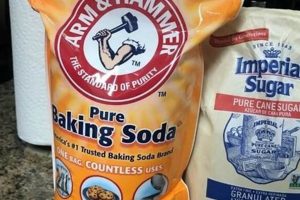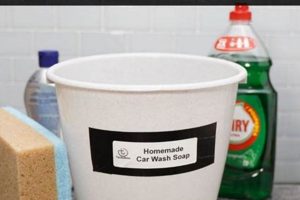A self-assembled apparatus designed for smoothing and polishing rocks and other materials through a process of abrasion is the focus. This equipment replicates the natural erosion process, accelerating it within a controlled environment. The fundamental principle involves placing rough stones, along with an abrasive grit and water, inside a rotating container. The continuous tumbling action causes the grit to grind against the rocks, gradually smoothing their surfaces.
Constructing such an apparatus allows for customization and cost-effectiveness compared to purchasing commercially manufactured units. Its relevance lies in its accessibility, enabling hobbyists, educators, and researchers to explore geological samples or craft polished stones for jewelry and decorative purposes. Historically, similar mechanical methods have been used for centuries in lapidary arts to refine and shape various materials. The ability to create such a device expands opportunities for hands-on learning and creative exploration.
The following sections will detail the necessary components, construction methods, safety considerations, operational procedures, and grit selection guidelines involved in creating a functional and effective polishing system. Furthermore, troubleshooting tips and maintenance advice will be provided to ensure longevity and optimal performance.
Expert Guidance
The following recommendations offer insights for optimal results and extended operational life. These suggestions are based on experience and aim to improve the performance and safety of the implemented polishing system.
Tip 1: Container Material Selection: Prioritize robust materials like high-density polyethylene (HDPE) or thick-walled PVC for the container construction. These materials exhibit resistance to abrasive wear and chemical degradation from prolonged exposure to grit and slurry.
Tip 2: Motor and Drive System: Employ a geared motor with appropriate torque for the intended load. Undersized motors will experience premature failure, while excessive speeds can damage the materials being polished. A speed control mechanism is beneficial.
Tip 3: Grit Progression is Critical: Adhere to a strict grit progression sequence, starting with coarse grit to remove significant material and gradually transitioning to finer grits for polishing. Skipping grit sizes diminishes the final finish quality.
Tip 4: Load Optimization: Maintain an appropriate fill level within the container, typically between one-half and two-thirds full. Overloading reduces tumbling action efficiency, while underloading can increase impact forces and potential damage.
Tip 5: Regular Inspection and Maintenance: Routinely inspect the container, motor, and drive components for wear or damage. Lubricate moving parts as needed and promptly address any issues to prevent system failure.
Tip 6: Safety Precautions are Essential: Always wear appropriate personal protective equipment, including eye protection and gloves, when handling abrasive materials and operating the equipment. Work in a well-ventilated area to minimize dust inhalation.
Tip 7: Noise Dampening: Consider incorporating noise-dampening materials around the tumbler mechanism. Continuous operation can generate considerable noise; mitigating this improves the working environment.
Following these guidelines promotes efficient operation, extends the lifespan of the equipment, and enhances the quality of the polished stones. Careful attention to these details minimizes the risk of operational issues and ensures a more satisfying experience.
The subsequent section will address common challenges and provide solutions to optimize performance and address potential issues encountered during the polishing process.
1. Abrasion
Abrasion forms the fundamental mechanism by which a self-assembled polishing apparatus achieves its intended function. The process involves the wearing away of material through repetitive friction, facilitated by abrasive particles suspended in a liquid medium within a rotating container. This controlled erosion allows for the smoothing and polishing of rough stones and other materials.
- Grit Composition and Hardness
The effectiveness of abrasion depends significantly on the composition and hardness of the abrasive grit. Materials such as silicon carbide or aluminum oxide are commonly employed, with varying grit sizes used in sequential stages. The Mohs hardness scale dictates the relative abrasiveness of these substances compared to the material being polished. Inadequate hardness or inappropriate grit size selection hinders the process.
- Slurry Viscosity and Composition
The slurry, a mixture of abrasive grit and liquid, plays a vital role in the abrasive process. The viscosity of the slurry affects the suspension of grit particles and their distribution across the material’s surface. The composition of the liquid (typically water) can also influence the rate of abrasion. Additives may be incorporated to enhance lubrication or prevent corrosion. Improper slurry management diminishes abrasion efficiency.
- Tumbling Action and Contact Dynamics
The specific motion generated within the rotating container dictates the contact dynamics between the abrasive grit and the material. The tumbling action must ensure consistent and even distribution of abrasive forces across the entire surface. Factors such as container shape, rotational speed, and fill level influence the nature of this contact. Suboptimal tumbling action leads to uneven abrasion and unsatisfactory results.
- Material Hardness and Resistance
The hardness of the material being processed interacts directly with the abrasive action. Softer materials will abrade more quickly than harder ones. Variations in hardness within a single stone can result in uneven polishing. Understanding the material’s properties is critical for selecting appropriate grit types and tumbling durations. A mismatch between abrasive and material hardness compromises the final polish.
These facets illustrate the intricate interplay between abrasion and the functionality of a self-assembled polishing apparatus. By carefully managing grit properties, slurry dynamics, tumbling action, and considering the material’s hardness, the rate and quality of abrasion can be optimized for effective surface refinement. The controlled application of abrasion is central to achieving the desired smoothness and polish on a range of materials.
2. Rotation
The cyclical movement is fundamental to the operation of a self-assembled polishing apparatus. The process depends on continuous rotation to facilitate the abrasive action necessary for smoothing and polishing materials. This physical motion provides the energy required to tumble the rocks and grit within the container, enabling the
gradual removal of surface imperfections.
The rate of rotation significantly influences the outcome of the polishing process. Insufficient rotational speed results in minimal abrasive action, extending the processing time. Conversely, excessive speeds can cause damage to the rocks due to increased impact forces. Proper calibration of the rotational speed is essential to achieve the desired balance between efficient abrasion and material preservation. The motor selection and drive mechanism must be engineered to provide a consistent and controllable rotational speed. Example: A motor with a speed range of 30-60 RPM, coupled with a belt-driven system, offers versatility for polishing various materials. Furthermore, the geometry of the container interior affects the tumbling pattern. Baffles or internal ribs can promote more effective mixing and even wear.
In summary, effective and controllable rotation is critical for a functioning polishing system. The rate, consistency, and mechanical implementation of the rotational movement directly impact the efficiency, quality, and safety of the process. Careful design and calibration are crucial to ensure optimal performance and prevent damage to the materials being processed. Understanding the relationship between rotational parameters and the polishing outcome enables users to achieve desired results with a self-assembled polishing apparatus.
3. Grit Size
Grit size is a critical parameter in the operation of a self-assembled polishing apparatus, directly influencing the rate of material removal and the final surface finish achieved. Inadequate grit size selection leads to prolonged processing times, unsatisfactory surface smoothness, or even damage to the materials being polished. The process typically involves a sequence of increasingly finer grits, beginning with coarse abrasives to remove substantial imperfections and culminating in fine polishing compounds to create a smooth, reflective surface. For example, using coarse silicon carbide grit (60-90 grit) initially allows for rapid shaping and the removal of sharp edges on rough stones. Skipping this step and proceeding directly to finer grits would result in significantly prolonged processing times and inefficient material removal.
The effectiveness of grit size progression is exemplified in lapidary practices, where a systematic transition from coarse (e.g., 60 grit) to medium (e.g., 220 grit), fine (e.g., 600 grit), and then to pre-polish (e.g., 1200 grit) stages is standard. Each stage serves a distinct purpose, gradually refining the surface and eliminating scratches introduced by the previous, coarser grit. Deviations from this sequence, such as using an excessively fine grit at the outset, would result in minimal material removal and render the process ineffective. The practical significance of understanding grit size lies in the ability to tailor the polishing process to specific materials and desired surface finishes. For instance, polishing softer stones like calcite requires finer grit sizes and shorter tumbling durations compared to harder materials like agate. The appropriate selection of grit size prevents over-abrasion and preserves the integrity of the material.
In conclusion, grit size is not merely a component of a polishing system, but an active variable that must be carefully managed to achieve predictable and desirable outcomes. Challenges associated with grit size involve ensuring consistent grit quality, preventing contamination between grit stages, and adapting the grit sequence to the specific properties of the materials being polished. The relationship between grit size and the resultant surface finish highlights the importance of precise control and informed decision-making in self-assembled polishing apparatus operation, linking directly to the overarching goal of achieving high-quality polished materials.
4. Container Seal
The integrity of the container seal is paramount to the functional operation of a self-assembled polishing apparatus. The seal’s primary purpose is to prevent the leakage of slurry, a mixture of abrasive grit and water, during the tumbling process. A compromised seal results in the loss of this essential medium, causing diminished abrasive action, potential damage to the drive mechanism, and environmental contamination. For example, a poorly sealed container using a rubber gasket may experience degradation due to prolonged exposure to abrasive particles, leading to eventual failure and slurry leakage. This leakage disrupts the polishing process, rendering the system ineffective and potentially damaging the surrounding environment.
The type of seal implemented directly influences the efficiency and lifespan of the equipment. Threaded lids with O-rings, compression fittings, or robust clamping mechanisms are common solutions to establish a secure seal. The selection of sealing material must also consider chemical compatibility with the slurry. Certain polymers may degrade upon prolonged exposure to specific abrasive compounds or pH levels, causing premature failure. For instance, a polypropylene container with a silicone sealant is often chosen for its resistance to common abrasive grits. However, the silicone sealant might degrade if exposed to strong alkaline solutions, thus emphasizing the importance of material compatibility. Proper seal maintenance, including regular inspection and replacement of worn components, contributes significantly to consistent performance.
In summary, a functional container seal is not merely a component, but a critical enabler of the entire polishing process. Compromised seals result in system failure, environmental contamination, and suboptimal polishing results. Careful selection of sealing materials, robust design, and regular maintenance are essential for ensuring the reliability and longevity of the apparatus. The significance of a well-executed container seal directly translates to efficient polishing, reduced operational costs, and environmentally responsible operation of a self-assembled polishing system.
5. Motor Torque
Motor torque represents a pivotal parameter in the functionality of a self-assembled polishing apparatus. It is the rotational force that the motor exerts, directly influencing the apparatus’s ability to maintain consistent rotation under load. Inadequate torque results in diminished performance, potential motor failure, and ultimately, a compromised polishing process. The required torque is determined by the combined weight of the materials being polished, the abrasive grit, and the liquid slurry within the rotating container, as well as frictional forces. If the motor cannot overcome these resistive forces, the rotation will slow or cease altogether, negating the abrasive action and hindering the intended purpose.
The selection of an appropriately sized motor necessitates careful consideration of the load characteristics. A motor with insufficient torque will struggle to initiate and sustain rotation, particularly at the beginning of a cycle when the load is at its maximum. This can lead to overheating and premature motor failure. Conversely, an oversized motor consumes more energy and may impart excessive force, potentially damaging the container or the materials being polished. A practical example involves comparing two polishing systems:
one utilizing a 1/4 horsepower motor with 10 inch-pounds of torque and another employing a 1/2 horsepower motor with 20 inch-pounds of torque. The former may be suitable for smaller loads, while the latter is better equipped for larger quantities of material, denser rocks, or longer operational cycles. Furthermore, the type of drive system employed, such as a belt-driven or direct-drive mechanism, impacts the torque requirements. Belt-driven systems can provide torque multiplication through gear ratios, allowing smaller motors to drive larger loads, while direct-drive systems require motors with higher inherent torque capabilities.
In conclusion, the selection of a motor with adequate torque is essential for the reliable and efficient operation of a self-assembled polishing apparatus. Insufficient torque undermines performance, while excessive torque poses risks of damage. The ideal motor torque is determined by a combination of load calculations, drive system characteristics, and operational requirements. Proper consideration of motor torque ensures consistent rotation, optimized abrasive action, and extended equipment lifespan, contributing directly to the achievement of high-quality polished materials. The ramifications of underpowered or overpowered motor choices demonstrate how torque demands careful calculation for a efficient diy rock tumbler setup.
6. Noise reduction
Noise mitigation constitutes a significant consideration in the design and operation of a self-assembled polishing apparatus. The prolonged tumbling process generates substantial noise levels, potentially creating disturbances and exceeding permissible noise exposure limits. Effective methods must be implemented to minimize these acoustic emissions.
- Enclosure Design and Materials
The design and materials utilized in the construction of an enclosure play a crucial role in noise reduction. Dense, rigid materials like plywood or medium-density fiberboard (MDF) effectively block sound transmission. Lining the interior of the enclosure with sound-absorbing materials such as acoustic foam or damping sheets further reduces reverberation and sound intensity. For example, constructing an enclosure with 3/4-inch MDF and lining it with 2-inch thick acoustic foam can significantly reduce the noise level emanating from the apparatus. The effectiveness of the enclosure depends on its airtightness and the absence of gaps or openings that allow sound to escape.
- Vibration Isolation Techniques
Vibration is a primary source of noise in a self-assembled polishing apparatus. Isolating the apparatus from its surroundings through the use of vibration-damping mounts or pads minimizes the transmission of vibrational energy to the supporting structure. Materials such as neoprene or rubber are effective in absorbing vibrations. For instance, placing the polishing apparatus on a thick rubber mat significantly reduces the transmission of vibrations to the floor, thereby decreasing noise levels in adjacent areas. The effectiveness of vibration isolation depends on the proper selection of damping materials and their placement beneath the apparatus.
- Motor Selection and Damping
The motor is a significant source of noise, particularly if it is not properly dampened or if it operates at high speeds. Selecting a quiet motor with low vibration characteristics is essential. Additionally, damping the motor housing with vibration-damping materials can further reduce noise emissions. For example, using a brushless DC motor, known for its quiet operation, and mounting it on rubber isolators minimizes motor-related noise. Applying damping compound to the motor housing can further reduce vibrations and associated noise. The appropriate motor selection and damping techniques directly impact the overall noise level of the apparatus.
- Container Material and Fill Level Optimization
The material of the container and the fill level also influence noise generation. Harder container materials, such as steel or rigid plastics, tend to amplify noise, while softer materials dampen it. Optimizing the fill level of the container minimizes impact forces between the rocks and the container walls, reducing noise. For example, using a rubber-lined container significantly reduces the noise compared to a steel container. Keeping the fill level between one-half and two-thirds full minimizes impact noise without compromising the abrasive action. Optimizing these parameters is crucial in the comprehensive approach to noise reduction.
These facets demonstrate the multi-faceted nature of noise reduction in the context of a self-assembled polishing apparatus. Addressing noise generation requires a comprehensive approach that considers enclosure design, vibration isolation, motor selection, and container optimization. Effective implementation of these methods contributes to a quieter and more comfortable operating environment and addresses potential noise pollution concerns. Further, noise reduction techniques demonstrate engineering knowledge for better user experience of a diy rock tumbler.
Frequently Asked Questions
The following addresses common queries regarding the design, construction, and operation of a polishing system. These questions aim to clarify key aspects and provide practical insights for successful implementation.
Question 1: What is the minimum container volume necessary for a functional polishing system?
The minimum container volume depends on the size and quantity of materials intended for polishing. A container volume of approximately 3 liters is generally sufficient for processing small batches of stones (up to 1 kilogram). Larger volumes are necessary for handling more significant loads or larger individual pieces.
Question 2: What type of motor is most suitable for continuous operation?
A geared DC motor or a shaded-pole AC motor with appropriate torque ratings is recommended for continuous operation. Geared motors provide the necessary torque at low speeds, while shaded-pole motors offer reliability and durability. Brushless DC motors represent a premium option, providing efficiency and longevity.
Question 3: How critical is the ratio of rocks to abrasive grit?
Maintaining an appropriate ratio of rocks to abrasive grit is essential for optimal polishing. A ratio of approximately 2:1 (rocks to grit by volume) is generally recommended. Insufficient grit results in prolonged processing times, while excessive grit can hinder the tumbling action and damage the materials.
Question 4: What are the safety precautions that must be observed during the polishing process?
Safety precautions must include wearing appropriate personal protective equipment, such as eye protection and gloves, to prevent contact with abrasive materials. The apparatus must be operated in a well-ventilated area to minimize dust inhalation. Overload protection should be incorporated into the electrical circuit. The equipment should be inaccessible to unauthorized personnel, especially children.
Question 5: How can excessive noise be mitigated?
Excessive noise can be mitigated through the construction of an enclosure using sound-dampening materials, such as acoustic foam or mass-loaded vinyl. Vibration-isolating mounts can reduce the transmission of noise to surrounding surfaces. Careful selection of a quiet motor and lubrication of moving parts also contributes to noise reduction.
Question 6: What indicators suggest that the abrasi
ve grit needs replacement?
Indicators that suggest grit replacement include a decrease in the rate of material removal, a change in the consistency of the slurry, and the presence of excessive sludge or debris. Regular inspection of the grit is necessary to maintain optimal polishing performance.
These responses provide a foundational understanding of key considerations for developing and maintaining a self-assembled polishing system. Careful attention to these aspects promotes effective and safe operation.
The following sections will delve into more advanced techniques and address complex challenges associated with various polishing methods and material types.
Conclusion
This exposition has explored the multifaceted aspects of the “diy rock tumbler,” providing a comprehensive overview of its construction, operation, and optimization. Critical elements, including abrasion principles, rotational mechanics, grit size management, container sealing, motor torque considerations, and noise reduction strategies, have been thoroughly examined. The document has clarified the essential factors for constructing and maintaining a functional and efficient polishing system.
The creation and effective utilization of a “diy rock tumbler” represent a valuable undertaking for hobbyists, educators, and researchers alike. Mastery of the techniques and principles outlined herein facilitates the transformation of raw materials into refined objects, enabling both artistic expression and scientific exploration. Further investigation and experimentation are encouraged to refine these methods and expand the application of this versatile apparatus.







